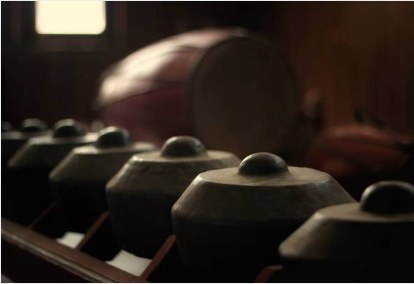Warning: Flashing lights during this program may affect photosensitive viewers
Program
Charles NICHOLS (b. 1967) - Liberosis (2022) for electric violin and computer (7:00)
Charles Nichols (electric violin and computer)
I Putu Arya Deva SURYANEGARA - (b. 1996) - Chocolate Meteor [Premiere] (15:00)
Ensemble Gamelan Giri Kedaton
I Putu Arya Deva SURYANEGARA (b. 1996) - Lengkong (2021) for two Gendèr Rabat and electronics (9:00)
Ensemble Gamelan Giri Kedaton
Charles NICHOLS (b. 1967) - Sonder (2021) for flute, alto saxophone and computer (7:00)
Elizabeth Lantz (flute), Kyle Hutchins (alto saxophone), Charles Nichols (computer)
I Putu Arya Deva SURYANEGARA (b. 1996) - Les chemins mènent à Gong (2021) for prepared Gong, Reyong, and electronics (15:00)
Ensemble Gamelan Giri Kedaton
Ticket Reservations
This event is open to the general public and free with reservation. Tickets are available through the Schulich School of Music box office several weeks before the event. *Now open!*
*For CIRMMT students wishing to have their attendance tracked for awards eligibility, please ensure to reserve your own ticket via the box office
We welcome you to share this event via Facebook.
Program Notes
Chocolate Meteor - A meteor shower of chocolate falls from space. The other children and I are jubilating. We chant “I love chocolate!” We also enjoy playing gamelan, there are no rules for us. We just hit the keys, fast and loud. The teachers seem happy when we play like this, as we are developing our muscles. We don’t follow any musical rules… I think that’s because we don’t quite get how it works. We just hit the keys, make sounds, and have fun with our friends. If there is no teacher, and we forget how the music goes, then how do we remember what to play? Time to eat chocolate while playing gamelan. Inspired by children in Bali, this composition explores unconventional textures for Balinese gamelan.
Lengkong is a Balinese word that means “to bend”. Lengkong uses a gamelan instrument called Gender Rambat, live electronics, and lights in order to "bend the tone" of gamelan through audio synthesis and manipulation of sounds. Recently, there has been an increasing interest among composers in Bali to retune gamelan instruments, producing new scales for contemporary pieces. Lengkong thus experiments with how we can "bend" the note and imitate the concept of ombak(waves; acoustic beats) according to the amplitude intensity of the instruments played by two musicians.
Sonder, as defined in The Dictionary of Obscure Sorrows by John Koenig, is the realization that everyone around you is living a complex and interesting story that you may never know. In the piece Sonder, for flute, alto saxophone, and computer, singing while playing, multiphonics, timbral trills, and flutter tongue serve as background textures to a lilting melody and rolling arpeggios, while the performance is recorded in the computer and played as looped accompaniment. Short samples of the performance, stored in video matrices, are processed with video filters, smearing and scattering the recording, while playing back the parts forward and backward. Longer samples are stored in buffers that are played back in different directions while rhythmically jumping to random sections of the recording. - Charles Nichols
Les chemins mènent à Gong is inspired by the Balinese philosophy of gamelan notes found in the Prakempa palm manuscript. In this philosophy, the tones are associated with the gods in Bali Hinduism. In composing a structural melody, as is done in traditional gamelan pieces, composers often choose tones that become dominant in their work according to ceremonial purposes. In this piece, the positioning of the instruments was similarly inspired by concepts found in the Prakempa. The musicians need to move to play the instruments, abiding to a predetermined set up. Moreover, this work applies composing and learning methods usually associated with oral tradition to a contemporary work of gamelan instruments and electronics.
Biographies
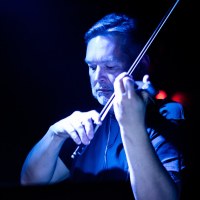 Charles Nichols (www.charlesnichols.com) explores the expressive potential of instrumental ensembles, computer music systems, and combinations of the two, for the concert stage, and collaborations with dance, video, and installation art. He teaches Composition and Creative Technologies at Virginia Tech, is a Faculty Fellow of the Institute for Creativity Arts and Technology, and previously taught at the University of Montana. He was a Technical Director at the Center for Computer Research in Music and Acoustics at Stanford and a Research Associate at the Center for Studies in Music Technology at Yale. He has composed as a resident at the Ucross and Brush Creek artist retreats, conducted research as a visiting scholar at the Sonic Arts Research Centre at Queen's University Belfast, and taught computer music workshops at the University of Rome Tor Vergata, Banff Centre, CCRMA, and the Charlotte New Music Festival. He has earned degrees from the Eastman School of Music, Yale University, and Stanford University, where he studied violin performance, composition, and computer music research.
Charles Nichols (www.charlesnichols.com) explores the expressive potential of instrumental ensembles, computer music systems, and combinations of the two, for the concert stage, and collaborations with dance, video, and installation art. He teaches Composition and Creative Technologies at Virginia Tech, is a Faculty Fellow of the Institute for Creativity Arts and Technology, and previously taught at the University of Montana. He was a Technical Director at the Center for Computer Research in Music and Acoustics at Stanford and a Research Associate at the Center for Studies in Music Technology at Yale. He has composed as a resident at the Ucross and Brush Creek artist retreats, conducted research as a visiting scholar at the Sonic Arts Research Centre at Queen's University Belfast, and taught computer music workshops at the University of Rome Tor Vergata, Banff Centre, CCRMA, and the Charlotte New Music Festival. He has earned degrees from the Eastman School of Music, Yale University, and Stanford University, where he studied violin performance, composition, and computer music research.
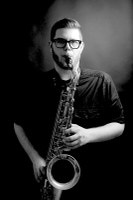 Kyle Hutchins (www.jefferykylehutchins.com) is Artist/Teacher of Saxophone at Virginia Tech. He has performed and been broadcast in Asia, Australia, Europe, North and South America, premiered over 200 new works for saxophone, and appears on over 20 albums. He is a Yamaha, Légère, and E. Rousseau Performing Artist and a member of 113 (One Thirteen), a collective of composers and performers of experimental new music who curate concerts, educational programs, festivals, seminars, and masterclasses around the world. He is one half of Binary Canary, a woodwind-laptop improvisation duo alongside electronicist Ted Moore. As a chamber musician, Kyle performs with ACUTE Trio, AVIDduo, The Broken Consort, Hutchins/Qiang Duo, The Poem Is Done, and Strains New Music Ensemble. He has a Doctor of Musical Arts and Master of Music degree from the University of Minnesota, and Bachelors of Music in performance and Bachelors of Music Education degrees from the University of North Texas.
Kyle Hutchins (www.jefferykylehutchins.com) is Artist/Teacher of Saxophone at Virginia Tech. He has performed and been broadcast in Asia, Australia, Europe, North and South America, premiered over 200 new works for saxophone, and appears on over 20 albums. He is a Yamaha, Légère, and E. Rousseau Performing Artist and a member of 113 (One Thirteen), a collective of composers and performers of experimental new music who curate concerts, educational programs, festivals, seminars, and masterclasses around the world. He is one half of Binary Canary, a woodwind-laptop improvisation duo alongside electronicist Ted Moore. As a chamber musician, Kyle performs with ACUTE Trio, AVIDduo, The Broken Consort, Hutchins/Qiang Duo, The Poem Is Done, and Strains New Music Ensemble. He has a Doctor of Musical Arts and Master of Music degree from the University of Minnesota, and Bachelors of Music in performance and Bachelors of Music Education degrees from the University of North Texas.
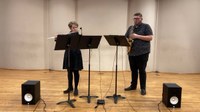 Elizabeth Lantz is Senior Instructor of Flute in the School of Performing Arts at Virginia Tech. She is a regular soloist and chamber musician throughout Virginia, the Mid-Atlantic region, and the United States, and has also toured in South America, England, and Trinidad. She performs regularly for the National Flute Association National Conventions, and in 2015 appeared on the convention’s Keynote Recital program, performing her newly commissioned composition by Valerie Coleman, Wish Sonatine for flute and piano. Lantz performed and taught in residency at the University of Trinidad and Tobago in 2016, and in recent years, was a featured International guest artist at the Festival y Concurso Internacional de flauta traversa de Sopó, Colombia and the Segundo Festival Internacional de Flauta Traversa en el Suroccidente Colombiano in Cauca, Colombia. She holds degrees from the University of Southern California and the University of Arizona and is a Yamaha Performing Artist.
Elizabeth Lantz is Senior Instructor of Flute in the School of Performing Arts at Virginia Tech. She is a regular soloist and chamber musician throughout Virginia, the Mid-Atlantic region, and the United States, and has also toured in South America, England, and Trinidad. She performs regularly for the National Flute Association National Conventions, and in 2015 appeared on the convention’s Keynote Recital program, performing her newly commissioned composition by Valerie Coleman, Wish Sonatine for flute and piano. Lantz performed and taught in residency at the University of Trinidad and Tobago in 2016, and in recent years, was a featured International guest artist at the Festival y Concurso Internacional de flauta traversa de Sopó, Colombia and the Segundo Festival Internacional de Flauta Traversa en el Suroccidente Colombiano in Cauca, Colombia. She holds degrees from the University of Southern California and the University of Arizona and is a Yamaha Performing Artist.
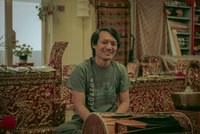 I Putu Arya Deva Suryanegara, artist-in-residence at the Université de Montréal, is a Balinese gamelan virtuoso versed in many of the musical traditions of the island. He graduated in the spring of 2018 from the Conservatory of Music in Denpasar, Bali (ISI Denpasar) with an original work entitled "O". This mixed-media piece incorporating micro-sensors on the drums, among other things, had the musicians interact with a digital device. Arya also leads his own Gamelan Naradha Gita ensemble, a group that creates many of his works in addition to performing traditional repertoire for various occasions. Arya is also involved in the art collective Insitu Recordings, a project to document, record and disseminate the music being made on the island of Bali today. Within this framework, he has been practicing as a sound technician, doing many sound recordings and recording several of his works. Arya has been developing this interest and talent for mixed/electroacoustic music and digital technologies for a little over four years, among other things through his studies in composition at the Université de Montréal. This artistic background makes Arya one of the few emerging composers to master both Balinese gamelan and digital technologies.
I Putu Arya Deva Suryanegara, artist-in-residence at the Université de Montréal, is a Balinese gamelan virtuoso versed in many of the musical traditions of the island. He graduated in the spring of 2018 from the Conservatory of Music in Denpasar, Bali (ISI Denpasar) with an original work entitled "O". This mixed-media piece incorporating micro-sensors on the drums, among other things, had the musicians interact with a digital device. Arya also leads his own Gamelan Naradha Gita ensemble, a group that creates many of his works in addition to performing traditional repertoire for various occasions. Arya is also involved in the art collective Insitu Recordings, a project to document, record and disseminate the music being made on the island of Bali today. Within this framework, he has been practicing as a sound technician, doing many sound recordings and recording several of his works. Arya has been developing this interest and talent for mixed/electroacoustic music and digital technologies for a little over four years, among other things through his studies in composition at the Université de Montréal. This artistic background makes Arya one of the few emerging composers to master both Balinese gamelan and digital technologies.
 Gamelan Giri Kedaton : In 1987, the Faculty added the "Balinese Gamelan Workshop" to its program. The popularity of the workshop led to several Balinese masters being invited to teach in Montreal from 1987 to 1995. During this period, the Faculty welcomed I Wayan Suweca from Denpasar twice, I Komang Astita, also twice, I Wayan Suweca from Batubulan and I Wayan Berata. In 1995, the idea of creating an autonomous ensemble under the name of Giri Kedaton, separate from the gamelan workshop, took shape. On August 14, 1994, the ensemble performed its first concert under its current name in Alexandria, Ontario. In 2002 Giri Kedaton was officially incorporated, and was granted "in residence" status by the faculty, along with NEM and Sixtrum. Since then, the group has remained the only ambassador of Balinese music in Quebec, in addition to developing its own contemporary repertoire. Giri Kedaton has premiered works by José Evangelista, Sylvain Mathieu, I Dewa Made Suparta, Alexandre David, Hugo Levasseur-Déziel and I Putu Arya Deva Suryanegara, in addition to having recorded the album of compositions and arrangements "Projet Bali X" (2009).
Gamelan Giri Kedaton : In 1987, the Faculty added the "Balinese Gamelan Workshop" to its program. The popularity of the workshop led to several Balinese masters being invited to teach in Montreal from 1987 to 1995. During this period, the Faculty welcomed I Wayan Suweca from Denpasar twice, I Komang Astita, also twice, I Wayan Suweca from Batubulan and I Wayan Berata. In 1995, the idea of creating an autonomous ensemble under the name of Giri Kedaton, separate from the gamelan workshop, took shape. On August 14, 1994, the ensemble performed its first concert under its current name in Alexandria, Ontario. In 2002 Giri Kedaton was officially incorporated, and was granted "in residence" status by the faculty, along with NEM and Sixtrum. Since then, the group has remained the only ambassador of Balinese music in Quebec, in addition to developing its own contemporary repertoire. Giri Kedaton has premiered works by José Evangelista, Sylvain Mathieu, I Dewa Made Suparta, Alexandre David, Hugo Levasseur-Déziel and I Putu Arya Deva Suryanegara, in addition to having recorded the album of compositions and arrangements "Projet Bali X" (2009).

